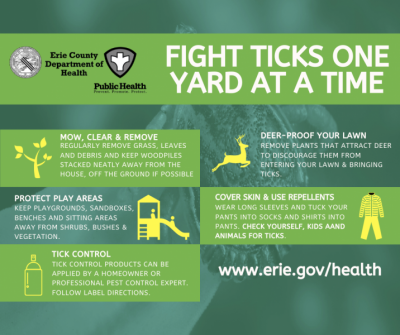Modified: May 27, 2021 10:30am
Latest News
TICKS THRIVE IN WARMER WEATHER
Erie County Department of Health advises residents to prevent bites and check for ticks on humans and pets
 ERIE COUNTY, NY – With warmer weather in store for Erie County, the Erie County Department of Health is reminding residents that this is the season for ticks and the tick-borne illnesses.
ERIE COUNTY, NY – With warmer weather in store for Erie County, the Erie County Department of Health is reminding residents that this is the season for ticks and the tick-borne illnesses.
Ticks – small, wingless, blood-sucking insects – are active from April through November in Western New York. Tick larvae, active from mid-May through July, are the size of a poppy seed and difficult to see. Ticks can be extremely small, so a thorough inspection on yourself and your children of skin and clothing – and pets – is necessary after gardening, camping, hiking and other outdoor activities.
When outside, people can take steps to prevent tick bites by covering exposed skin and tucking long-sleeve shirts into pants and pants into socks. Use insect repellent that has 20% or more DEET, picaridin or IR 3535; use these repellents according to their labels, and do not use on children under two months of age.
“Where there are ticks, there can be tick-borne diseases. Lyme disease is the most commonly reported tick-born disease in the United States, and is transmitted through the bite of an infected black-legged tick,” said Commissioner of Health Dr. Gale Burstein. “Fever, headache, fatigue and a characteristic bull’s-eye skin rash are typical symptoms, and people may develop more serious and lingering complications.”
Ticks found on skin must be carefully and completely removed. The best technique is to use a pair of fine-tipped tweezers to grasp the tick as close to the skin as possible, and pull upwards with steady, firm pressure. The risk of developing Lyme disease is extremely low if the tick is attached less than 36 hours. Testing of the tick for spirochete infection has a poor predictive value and is not recommended.
If you or a family member has had a tick bite, monitor for symptoms and consult your health care provider with any concerns. Most cases of Lyme disease can be treated in its early stages with antibiotics.
How Can I Reduce Ticks in My Yard?
- Keep lawns mowed and edges trimmed
- Clear brush, leaf litter and tall grass around the house, and at the edges of gardens and stone walls
- Stack woodpiles neatly away from the house and preferably off the ground
- In the fall, clear your yard of all leaf and garden litter, where ticks can live in the winter
- Keep the ground under bird feeders clean so as not to attract small animals that can carry ticks into your yard
- Locate children's swing sets and other play equipment in sunny, dry areas of the yard, away from the woods where ticks can be abundant
- Using an approved insecticide once a year (in June) can significantly reduce tick numbers on a residential property
How Do I Protect Myself and Family?
- Avoid direct contact with ticks
- Avoid wooded and brushy areas with high grass and leaf litter.
- Walk in the center of trails: stay on cleared trails when walking or hiking, and avoid the edge habitat where ticks are likely to be.
- Repel ticks on exposed skin with repellent that contains 20 percent or more DEET, picaridin or IR3535. Do not use on children younger than two months. Use according to instructions on the label.
- Treat clothing, socks, shoes, boots, and camping gear with products that contain permethrin; do not use this on skin. It can remain protective through several washings. Pre-treated clothing is available and may be protective longer.
- Wear a long-sleeved shirt and long, light-colored pants tucked into socks or closed-toed shoes. Talk to your veterinarian about effective tick control options.
Find and Remove Ticks from Your Body
- Bathe or shower as soon as possible after coming indoors (preferably within two hours) to wash off and more easily find ticks that are crawling on you.
- Conduct a full-body tick check using a hand-held or full-length mirror to view all parts of your body upon return from tick-infested areas. Parents should check their children for ticks under the arms, in and around the ears, inside the belly button, behind the knees, between the legs, around the waist, and especially in their hair.
- Examine gear and pets. Ticks can ride into the home on clothing and pets, then attach to a person later, so carefully examine pets, coats, and day packs.
- Tumble dry clothes in a dryer on high heat for 10 minutes to kill ticks on dry clothing after you come indoors. If the clothes are damp, additional time may be needed. If the clothes require washing first, hot water is recommended. Cold and medium temperature water will not kill ticks effectively. If the clothes cannot be washed in hot water, tumble dry on low heat for 90 minutes or high heat for 60 minutes. The clothes should be warm and completely dry.
#
- ECDOH – Ticks and Lyme Disease: http://www2.erie.gov/health/index.php?q=ticks-lyme-disease
- New York State Department of Health-Lyme disease & Tick Bite Prevention: https://www.health.ny.gov/publications/2813/
- NYSDOH-Tick Repellent: Dress to Repel: https://www.health.ny.gov/environmental/pests/dress_to_repel.htm
- Centers for Disease Control and Prevention-Lyme disease: https://www.cdc.gov/lyme/
- Environmental Protection Agency-Select Proper Insect Repellant: https://www.epa.gov/insect-repellents
###

